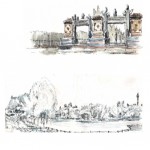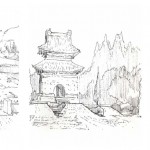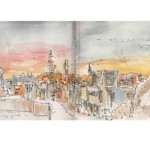SANDRO PARRINELLO Architectural drawing of professor Sandro Parrinello
From West to the East……starting in Europe and ending in China
A trip to the East
Signs and drawings in search of models and architectural styles that characterize the landscape of the West.
The line, drawn on a sheet of paper, always expresses a direction, a beginning and the end. As part of a drawing the line tells the journey in understanding the composition that is drawn. The drawing is for the architect an instrument of knowledge, a practice to deal with a specific cultural landscape through which to project himself in a certain place.
My drawings are notes, fragments of adventures, so mostly random, signs from which reading the atmosphere of a certain place. I do not know if the drawings are true and reliable, sometimes I try to be meticulous, sometimes I’m not drawing the landscape, but only my state of mind. Although they were all drawn on the place, some are completed on memory because many landscapes are fast and remain in front of the eyes for a few moments, before changing colours or disappear behind a bend of a road at the back of a hill or a dune. These drawings are only a fragment of the many illustrations in my notebooks and perhaps that there is a perception of a fragmented trip, an unfinished journey. None of these represent the travel life, no one speaks of time spent in the airports or stations, and no one represent the views of the interior of cars or people meetings. The journey in this case is static and it must be inferred through the reading of the landscape that varies between the different sections of the exhibition. From the drawings of the Caribbean to the Chinese mountains, while not varying the graphic technique, the thickness of lines changes. Changing pace and hatches in the drawings show a different atmosphere. This atmosphere, behind the journey, underlines the movement of a cultural model, of an environment which is possible to find again in some other drawing, maybe after few sketches.
The common denominator is that all of them were made during research missions, during breaks, seating in a car or in a bus, or trying to explain to myself how something works, an architectural technology, a colour... Moreover, the research conducted abroad often assumes the characteristics of a trip where the researcher moves in the learning of languages and signs that are used to build, step by step, a landscape within which to develop their own considerations. This procedure is most evident when the study turns to the borderlands between cultural contexts. The research of the signs, languages, forms and cultural patterns, configures a reflection that distorts the paradigm of knowledge, expanding horizons and perspectives.
This journey, presented through drawings, moves from the west, from the American colonies, to the east, entering Europe, in the Mediterranean and then moves to the Middle East and finally in China.
It is an incomplete journey, numerous references are missing, but collects the main places of my travels, and it is a journey that follows the origin of architecture, stylistic and formal models, highlighting the boundaries of such models.
It's not just a trip to the east, is a journey that moves at different latitudes from south to north from the Caribbean architectures to those of northern Russia, is a journey that moves in search of life and of a landscape made concrete in the architectural works.
Part 1 The colonies in the Americas
Part 2 The old continent? Europe
Part 3 The North and Russia
Part 4 Eastern Europe
Part 5 Istanbul: the gateway to Asia
Part 6 The Middle East
Part 7 The great Persia
Part 8 The Far East and China




